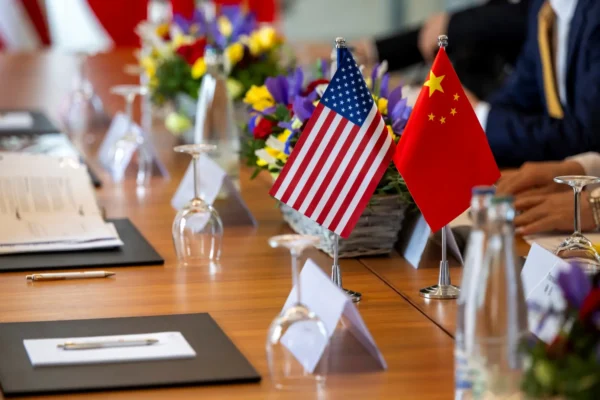U.S.–China tensions are rising over trade, tech, and diplomacy. Learn how both sides are maneuvering, what’s at stake, and where this rivalry may head.

🌍 A Relationship on Edge
The relationship between the United States and China has entered a sensitive phase.
Trade wars, tech restrictions, and diplomatic rivalries are building a wall between two of the world’s most powerful nations.
This growing tension affects markets, businesses, and ordinary people worldwide.
To understand this complex situation, we need to look at the key fronts of conflict and how both sides are reacting.
For related U.S. political issues, see U.S. Shutdown: Everything You Need to Know and Global Debt Surge: A Challenge for All. These events are deeply connected to America’s diplomatic posture.
💼 Trade & Tariff Battles
Trade is at the heart of this confrontation.
The U.S. has warned China that it could impose 100% tariffs on certain imports. This move aims to pressure Beijing to reverse its strict export policies.
China, in turn, has limited exports of crucial raw materials like rare earth elements, which are essential for making electronics, defense equipment, and clean energy technologies.
This tit-for-tat approach is shaking global supply chains. Many industries are already struggling to adjust their sourcing strategies, which have been built around Chinese manufacturing for decades.
External platforms like America112.com have been closely following the trade developments and their global impact.
🧠 Technology: The New Battleground
Beyond goods, the technology sector has become the new battlefield.
The U.S. has tightened restrictions on the export of advanced chips and AI-related technologies to China. This is part of a larger effort to slow Beijing’s technological rise.
China has responded with strict rules requiring companies to get licenses to export products containing Chinese-origin rare earths — even in tiny amounts. This affects global manufacturers that rely on Chinese materials.
As both countries tighten their tech policies, companies across Asia, Europe, and the Americas are forced to rethink their future. Supply chains that once ran smoothly are now facing delays, uncertainty, and rising costs.
🌊 Strategic & Military Flashpoints
Tensions aren’t limited to trade and technology.
They are spilling into the South China Sea and around Taiwan, where both sides are asserting their strategic interests.
Recent maritime incidents have heightened fears of a direct confrontation. These waters are vital shipping routes, and any escalation could disrupt global trade on an unprecedented scale.
Diplomatic communication lines remain open, but mistrust continues to grow. Each military movement is being closely watched by allies and adversaries alike.
🕊️ Diplomatic Signaling: Words with Weight
Diplomacy plays a delicate role in this rivalry.
The U.S. is pushing for greater transparency and rallying allies to reduce their dependence on Chinese markets.
China is calling for calm, emphasizing dialogue, and warning against confrontation.
Meetings between senior officials and potential talks between President Trump and President Xi are viewed as critical pressure valves. These conversations may not solve everything, but they could keep the situation from spiraling further.
🌐 Global Ripple Effects
The rest of the world is not just watching — it’s feeling the shockwaves.
Market Uncertainty
Global markets react strongly to each announcement. Asian stocks often surge or fall depending on the tone of trade discussions. Gold prices rise when tensions increase, as investors look for safe havens.
Supply Chain Shifts
Many companies are adopting a “China + 1” strategy. This means diversifying production to other countries while keeping some presence in China. It’s not easy, but businesses know they must adapt to survive.
Political Alignments
Countries in Asia, Africa, and Latin America are weighing their options. Some are deepening ties with China to benefit from investments. Others are aligning more with the U.S. to secure trade deals and strategic support.
👥 The Human Side of the Story
Behind every policy decision, there are people.
- A factory worker in Vietnam might lose contracts because of new export rules.
- A chip engineer in California may face layoffs if supply chains break down.
- A family in Taiwan lives with daily uncertainty as military tensions rise nearby.
These are not distant geopolitical games — they touch real lives across the world.
🛤️ The Road Ahead: Can Diplomacy Prevail?
Both nations have powerful incentives to avoid a full-blown confrontation.
Experts suggest three key steps to stabilize relations:
- Keep communication lines open, even during disagreements.
- Set clear boundaries to prevent accidental escalation.
- Cooperate in areas where both sides benefit, like climate change or global health.
Whether these steps are taken seriously will shape the future of U.S.–China relations.
🔎 What to Watch Next
- Will the planned Trump–Xi meeting lead to real breakthroughs?
- Can China relax its export curbs without losing face?
- How far will the U.S. push tariffs and tech bans?
- Will other nations be forced to pick sides as the rivalry deepens?
✍️ Final Thoughts
The U.S.–China rivalry is more than a political contest.
It’s a defining global story that affects economies, security, and everyday lives.
Diplomacy has the power to cool the flames — but only if both sides are willing to act with foresight and responsibility.
For continuous updates and deeper analysis, check out America112.com, which tracks the evolving situation closely.

